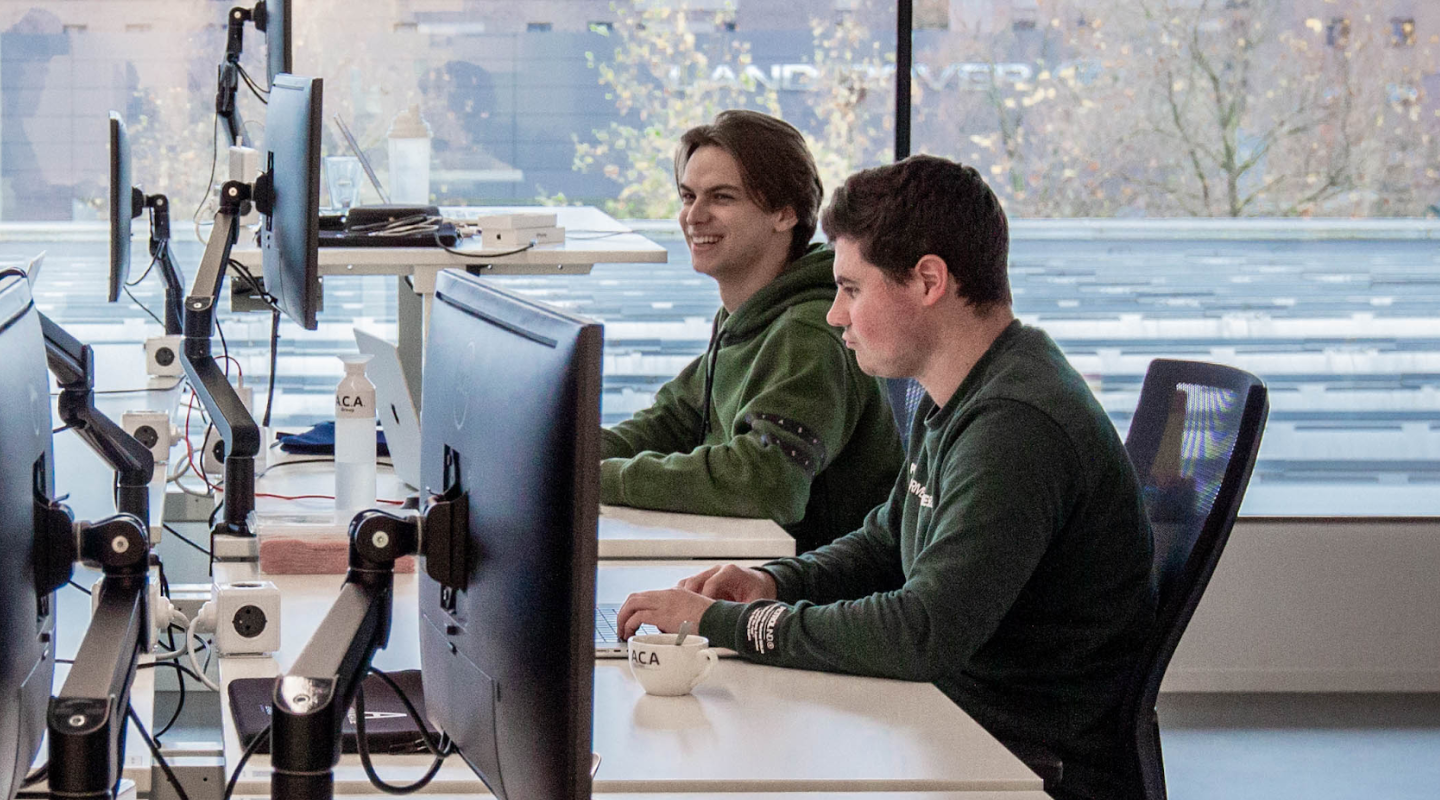
How we organize remote work as an IT company
COVID-19 has forced a lot of people to temporarily stop working, or in our case, work from home. But what are our practices and tools we use to facilitate remote work? In this blog post, we’ll go over some tips and tricks about how we organize remote work.
Communication is key
When you’re not physically able to connect to others, communication in various formats and through various channels becomes even more important than it already was. Here’s a few ways we maximize our communication when working remotely.
- Get a clear view on the tasks at hand for your team, who’s working on what and what the priorities and due dates are. This provides clarity on what’s happening in the team. You can add some time registration elements on top to help you build statistical and graphical dashboards. Make sure that the tasks at hand are always up-to-date!
- Frequently organize team meetings, in which every team member can add topics at any time of the week. Set some time limits per subject, try to be prepared for your subject (with a proposal or clear context statement with a roundtable discussion).
- Start off every morning with a stand-up meeting in which you discuss what you’ve done the day before, what you’ll be doing today and whether you’ve encountered any problems. A stand-up usually takes only 10 to 15 minutes and helps you and your team communicate and feel connected. If you can you may reference a task that was set on the task board.

- Hold remote retrospective meetings. Typically held with the help of a video conferencing tool, its goal is to allow the team to reflect on the work done and determine how they can use that knowledge to improve moving forward. It’s a great way to duplicate your successes and learn from your failures. Retrospective meetings are, just like stand-ups, a way for you and your team to connect. If you’re working remotely, turning on the camera on your laptop or smartphone will help you respond and react to each other in a more real way.
- As people are less physically together it’s important to measure your team health, and get a good feeling of the overall team well being. Don’t forget that a lot of communication will be more point-to-point and less in groups. Reflect on the results together and define actionable items to work on for the upcoming period.
- You can potentially add a stand-down meeting to give everyone some time to reflect on the day and some challenges that were presented. This ensures that those challenges aren’t just forgotten the next day.
- Take your time to speak individually with team members via video calls, and not just through regular chat. This applies especially when you’re a team coach or manager and are working on short and long term objectives with your team members. Give them your feedback on a frequent basis and write them down together. This will help in being transparent and setting clear expectations.
- Open up a team channel for chatting seriously but also one for fun. It might be interesting for the whole team to hear you reflect out loud when you’re writing an email or chatting with somebody else. After all, when working next to each other in an office setting, there are usually lots of light-hearted conversations and opportunities to have a good laugh.

The tips above mainly apply when you’re keeping in touch with your team members. But team members aren’t the only ones you need to keep in contact with.
- When communicating with customers in projects, have them collaborate closely on your task board, visual project dashboards and composed metrics. This will provide transparency for everyone who’s part of the project. Additionally, take out some extra time to reflect together on the status of the project.
- When communicating with end users in support desks, provide them with a clear helpdesk that streamlines all questions and incidents to provide simpler support. Both your end users and support desk agents gain by having a single channel for communication.
- When involved in software development projects, techniques as event storming, story mapping, pair programming, mob programming, sprint or weekly demo’s, story kick-off, epic kick-off, sprint planning, story writing, epic writing and many more will have to be applied more in detail to facilitate correct communication and avoid waste. All these techniques can also be applied when working in a remote context. For some tips on the right tools, check below!
- Build and expose the much needed dashboard to give clear insights on system availability, alerts, team, project or company performance
- Broadcast management communication transparently and frequently. Contact with your management might get more distant than ever, so do it more often and not only via text but via video.
But most importantly: apply continuous improvement to all the points above. Some might work in your context, and others might not. Or new elements, particular to your concrete situation, might arise. Therefore, allow your communication practices to evolve. There is no final stage you can reach, and there’s always room for improvement!
Tools are secondary
Communication is key, but you need the tools to facilitate that communication. Below is a set of tools we have come to use over time.
Task boards
We have been adopting the Atlassian tools for more than 10 years now, so we have gotten used to define all of our work in tasks in Atlassian Jira and its marketplace apps. Not only for our software processes but also for HR, fleet management, marketing, finance, legal, project management, logistics, internal, helpdesks and so on. Some of our most used apps on top of that are Tempo, EazyBI, Structure, Portfolio, Dataplane, Insight and many more.
Retrospective meetings
There are quite a few tools available for remote retrospective meetings. At ACA, we prefer TeamRetro. The tool supports different formats for retros, but most of them are pretty standard. If you want some more uncommon formats for your retros, you’ll have to look elsewhere. You can sign up for a 30-day free trial.
Whiteboards
Whiteboards are easy to use in a face-to-face environment, but it’s a different story to do so online. Luckily, you can easily create interactive whiteboards in Zoom. Start a Zoom video call, share your screen with other participants and select ‘Whiteboard’. Then, click ‘Annotate’ and you can start drawing and writing! The whiteboard is interactive for all meeting participants. Afterwards, you can easily save the whiteboard by clicking the ‘Save’ button.
Miro is another tool we can recommend when it comes to whiteboards. Miro allows you to create and collaborate on whiteboards, but also share these. Additionally, Miro includes a mind mapping tool.
A Google JamBoard can also get you started collaborating with fellow team members.
Video Conferencing
For all kinds of video collaboration zoom.us is our tool of preference. It offers the possibility to join up to 49 people in one call, share screens and presentations, collaborate, pass control, and its chat options give tremendous flexibility when working together. Finally, its recording option is pretty powerful, making it easy to share a session with people who were unable to attend.
Chatting
When organizing or facilitating remote work, the ability to work together is crucial. There are a number of tools that can help you with this. Slack is well-known chat application that we use to help our teams communicate. You can chat directly, in teams or topic-oriented. Additionally, people can choose which channels they’d like to follow.
Content management
Confluence is a great tool to help teams organize their work and collaborate. Confluence is particularly great when working remotely because it inspires conversation as well: it encourage everyone to share announcements, strengthen company culture, and give/get instant feedback. Plus the collaborative editing features are really powerful, try them! Confluence also serves as our main channel for internal blog posts and spreading information throughout the organization.
Additionally, we make extensive use of Google Apps for their co-creation functionalities. For example, Google Documents when creating blog posts like this one or Google slides when preparing and sharing presentations.
DevOps
We combine tools and techniques like BitBucket, Jenkins and Jira to have everyone work in a similar way (test, code, validate, pull request) so that handing over work and releasing it happens in the same way as many open source projects do (since those often also work with people remote and in different time zones).
What about performance?
P = f(p,e). Performance is a function of a person and their environment.
Is working remotely more or less productive for someone? Often, working remotely means you’re more productive due to less interrupts. However, these are unprecedented times, so it’s not fair to make a comparison at this moment. We are but human and are overwhelmed by the news, the current situation and any personal feelings that might trouble our minds and distract us.
Regardless of that aspect, here are some tips that can apply when working from home:
- Treat yourself for some fresh air and getting up from time to time for a short break. Having a quieter environment and a serious backlog might drain your resources faster than normally.
- Structurally or during a longer time, working remotely might give a feeling of loneliness or being less interactive. Don’t hesitate to free your mind for a second by talking to your family, pets or house members.
- Take a step back from time to time and reflect on the next things to do. Techniques as Getting Things Done (GTD by David Allen) might help.
- Make a clear agreement on working hours and end your working day as you would do normally to keep work and personal stuff separated.
- Get yourself a quiet and well-lit space with a comfortable desk and chair, and possibly a second screen. Keep this space clean and organized. A view outdoors will always allow you to have a much needed distraction from your computer screen.

Some final tips
- Use threads instead of new chatlines in chat apps to avoid endless scrolls in channels.
- Promote the use of collaborative editing, it really works and is much more fun to do!
- If you’re having troubles with your video feeds, check the upload connection speed of your internet provider and possible extensive usage of family members at the same time such as Netflix and YouTube.
- Set a custom background in video chats to brighten up your video feed and put a smile on your team members face.
- Hold video calls with your team without a particular goal, just to chat and work as if you’re still sitting next to each other.
Some external references that also contain good information:
- Atlassian remote work tips
- Tips for Managing Performance Remotely
- Time magazine: It's Hard to Make Remote Work Actually Work
- How to Pivot to Remote Work During the Coronavirus Emergency
- FDN: loosened telework requirements amid coronavirus spread
- Atlassian working from home tips
- Trello's blog posts on remote work



